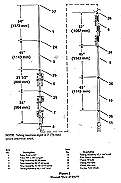
Hy-Gain DX-77
INTRODUCTION
Below is a series of shots showing the erection of the first real HF antenna at the new house.
The location is in the vacant land to the East of the house, about 75 feet away. The location is about 150 feet from the road and is somewhat hidden by the young trees between it and the road.
The pipe I chose to use is the bottom section of a 40-foot telescoping mast that my good friend Jim Fitzreiter, K3QHO, gave me 25 years ago. I used it to support my first antenna at my new home when we moved to Rochester in 1976. That mast supported a trap dipole (inverted-V) for several years before being replaced by a 30 foot tower and a Mosley TA-33 tribander.
The bottom section next saw service as the pedestal to support our bird feeder and was in place about 15 years. Today, it will be the base for another antenna I bought used at the Rochester Hamfest in June 2001.
 (The
photo at the right is the deer at the old house admiring the
pole holding the bird feeder.)
(The
photo at the right is the deer at the old house admiring the
pole holding the bird feeder.)
The antenna is a 30-foot end-fed self-supporting vertical shown on the left. Believe me, it is a real tail wagging a dog.
The Hy-Gain installation instructions call for a two-inch pipe three feet in the ground surrounded by concrete. Not wanting to lock this old and trusty pipe into a marriage with a hundred pounds of concrete, I tried to come up with an alternative. I could not pound the pipe into the ground more than a foot, in spite of what appeared to be fairly soft ground. However, this did not surprise me as the land around the house is peppered with stones of all sizes and I thought this may be just the same.
My next and really the first step, was to try to dig a hole in the ground to see what the soil was like. Much to my surprise, I was able to dig a three foot hole and never even seen a rock, not one! Not even one the size of a pea! I could not believe it. The soil is nothing but sand below four inches of topsoil.
Trying to avoid concrete, I remembered what one old timer told me, "It is not the weight of the concrete that is used to keep the tower or pole erect, it is the surface area." So, I decided to increase the surface area of the two-inch pipe by placing it into a scrap of four-inch pipe. The I hammered the two-inch pipe as far into the soil as I could--about eight inches-and filled in the larger pipe with the sandy soil. Voila! The pipe now has an effective diameter of four-inches. It will take twice as much pressure to displace the earth outside the pipes and I will be able to easily dig up the pipe and move it to another location, if it is required.
To keep the antenna from swaying too much in the wind, I am planning on guying it with some black Dacron rope.
Keep tuned for updates on this page.
73,
Chuck
K3NAU
